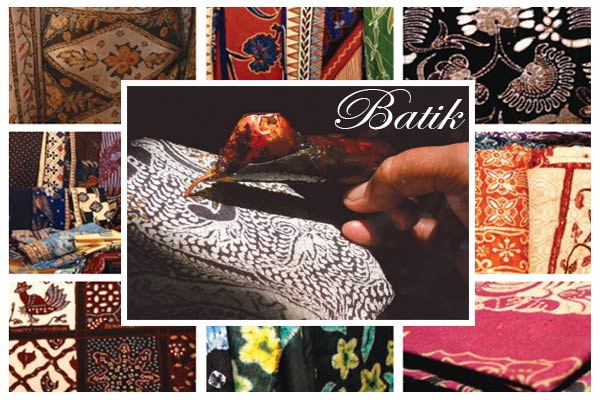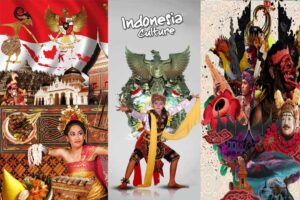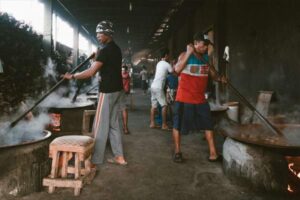
Historians wrote that the creation of batik began in the era of the Majapahit Kingdom, which was then distributed to other kingdoms, including Mataram.
The word batik is derived from the word amba nitik which means carving dots. At that time, batik was made on a woven white cloth. The dyes were taken from native plants of Indonesia such turmeric, Soga, indigo. Soda was made from soda ash and salt was taken from the mud.
From Javanese language canthing. Small tools from copper to make batik. The handle is made of bamboo. Using this canting batik patterns are painted with a liquid wax.
Batik was originally born from the technique of writing. The book “20 years GKBI”, explained that batik eventually became an art of the Indonesian people in the late of 18th century and the emergence of new printed batik was in the 1920s. This was after the Chinese traders brought imported fabric and artificial coloring.
The trace of batik from the Majapahit era was seen in Mojokerto and Tulungagung but batik then developed rapidly in Solo and Yogyakarta. In the city that is known for its royal batik – Yogyakarta – batik began to be wellknown when the kingdom of Mataram I was ruled by Panembahan Senopati. The creation of batik that took place in the palace eventually spread through the courtiers. When the Dutch invasion occurred and the royal family was forced to take refuge, they remain to spread batik in the places they stopped by. Until eventually batik was able to be found all over Java.
To the west, batik spread from Pekalongan up to Jakarta. In each region such as Pekalongan, Tegal, Ciamis, Tasikmalaya, Cirebon, Garut and Jakarta, unique motifs and colors emerges. Immigrants from abroad also contribute in the creation of batik patterns and colors in the coastal areas. Batik from the coastal areas is known for their bright colors. Brown color is no longer dominant. From Central Java, batik spreads its charm to East Java. The development of Batik in this area is related to the spreading of Islam. Beginning in Ponorogo, the person who spreads the Batik is still a descendant of the Majapahit, named Raden Katong, who was the brother of Raden Patah.
Batik was not only spreading in Java, but also penetrated Sumatra. In Padang, emerged batik with the motive color of black, yellow and red-purple with mixed patterns of Banyumasan, Indramayu, Solo and Yogyakarta. Created using the stamp technique, the pattern copied the batik patterns from Java. The first company in West Sumatra that produced batik was located in Padang Pariaman in 1946.
Batik was then also well-known beyond the archipelago; motivating admirers of batik to give birth to various other kinds of batik. Batik from neighboring countries like Thailand, Malaysia, Vietnam, India and Africa was then emerging, of course, with modifications. Choice of fabric is no longer fixed on cloth, but also silk which is more elegant. Batik was then found everywhere, in small outlets in the market, also luxurious boutiques.
Diversity of batik motif
Motifs of the batik continue to diversify. When exploring batik centers in different regions, different shades and colors of batik can be found. Originally, the batik motifs have specific meaning and were just around the classical style, typical of the palace – ceplok blah kedhaton, ceplok naga raja, kawung, parang barong bintang leider, parang kesit tumaruntum, parang seling huk, tambal, tambal nitik. Nowadays the motifs of batik reach up to 400 types.
In general, the motifs of batik can be divided into two types: geometric and non-geometric. Geometric motifs are usually in the form of lines, such as kawung, parang, and panji. The philosophy behind this type of motif indicates the government bureaucracy. From the king to the people or manunggaling kawula gusti there is a certain order. Apart from that is the non-geometric motif where pictures of animals and plants can be seen. This motif describes the life that continues to grow.
There is an unwritten rule in the selection of the batik motif. Royal style batik such as parang and kawung should not be used by ordinary people. However, the charm of batik makes it impossible for the unwritten rule to be applied. Not many people understand that batik with parang motif should only be worn by the king. Nowadays, the parang motif is worn by everyone, young or old, descended from the royal or common people. What happens now is that batik has inhabited the heart of everyone.
Batik, A String of Beautiful Dots – Temporaktif






